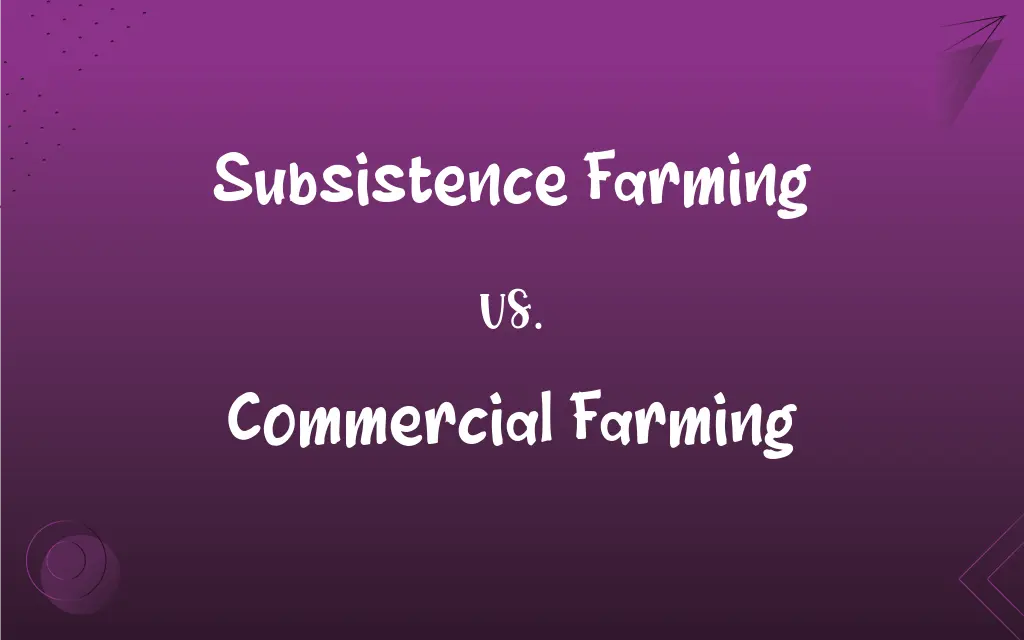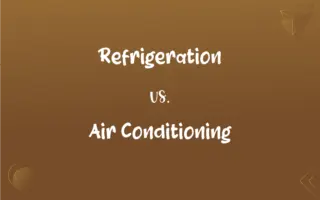Subsistence Farming vs. Commercial Farming: What's the Difference?
Edited by Aimie Carlson || By Harlon Moss || Updated on October 15, 2023
Subsistence farming is for family consumption with little surplus. Commercial farming is for profit through large-scale production.

Key Differences
Subsistence farming is an agricultural practice primarily focused on producing enough food to meet the needs of the farmer's family. In this type of farming, the output is generally limited, ensuring the family's survival but with little to no surplus for sale. Commercial farming, on the other hand, is primarily driven by profit, involving the large-scale production of crops for sale in local, national, or international markets.
Subsistence farming often utilizes simple tools and traditional methods. It's rooted in self-sufficiency, with farmers relying on their produce for sustenance. Commercial farming, in contrast, frequently uses advanced technologies, machinery, and farming techniques. The aim is to maximize output and profit, often requiring significant investments.
Land size differs between subsistence farming and commercial farming. Subsistence farming is generally practiced on smaller plots of land, sufficient for the family's needs. Commercial farming, however, involves vast tracts of land dedicated to a single or limited variety of crops to achieve economies of scale.
The market orientation of both farming types is also distinguishable. Subsistence farming is less market-oriented, as its primary concern is feeding the farmer's household. Commercial farming is market-centric, focusing on producing goods in response to market demands, often targeting a broader consumer base.
Subsistence farmers might face challenges like unpredictable weather conditions, which can jeopardize their food security. Commercial farmers, though they have more resources, can be susceptible to market fluctuations, global demand shifts, and large-scale pests or diseases.
ADVERTISEMENT
Comparison Chart
Purpose
Feed the farmer's family
Profit-driven
Scale
Small-scale
Large-scale
Tools & Technology
Traditional tools & methods
Advanced machinery & techniques
Land Size
Smaller plots
Large tracts
Market Orientation
Less market-oriented
Highly market-oriented
ADVERTISEMENT
Subsistence Farming and Commercial Farming Definitions
Subsistence Farming
Farming using traditional methods on small plots.
Subsistence farming relies on age-old techniques passed down through generations.
Commercial Farming
Farming that prioritizes maximizing output and revenue.
Commercial farming invests in research to achieve higher yields and profits.
Subsistence Farming
Agriculture with little to no surplus produce.
Subsistence farming ensures the family's survival but rarely results in extra to sell.
Commercial Farming
Agriculture on vast lands for economies of scale.
Commercial farming of wheat spans thousands of acres for bulk production.
Subsistence Farming
Farming without reliance on market sales.
In subsistence farming, families consume most of the produce, with little left for trade.
Commercial Farming
Agriculture using advanced techniques for large-scale production.
Modern commercial farming heavily employs machinery for efficient output.
Subsistence Farming
Farming producing enough for the family's consumption.
In many remote areas, subsistence farming is the primary way families secure food.
Commercial Farming
Farming with production geared towards market demands.
Commercial farming in the Midwest often centers on corn due to its versatile market uses.
Subsistence Farming
Agriculture aimed at self-sustainability.
Through subsistence farming, families grow diverse crops for a balanced diet.
Commercial Farming
Farming focused on profit through selling produce.
Commercial farming of soybeans is popular due to high global demand.
FAQs
Why is subsistence farming limited in output?
It focuses on meeting family needs with little to no surplus for sale.
Can subsistence farming lead to commercial farming?
Yes, as farmers expand and start producing surplus, they might transition to commercial farming.
What's the main purpose of subsistence farming?
The main purpose of subsistence farming is to produce enough food for the farmer's family.
What technologies are common in commercial farming?
Commercial farming often uses tractors, irrigation systems, and genetically modified crops.
Is subsistence farming sustainable?
It can be sustainable but may lack resources or technology for improved yields.
Is subsistence farming prevalent in developed countries?
It's more common in developing nations, though some in developed countries practice it for self-sustainability.
Can subsistence farming be a choice rather than a necessity?
Yes, some choose it for a self-sustaining lifestyle, even if they could opt for commercial methods.
Are subsistence farmers reliant on markets?
Subsistence farmers primarily grow food for their own consumption, with little reliance on markets.
What's a key challenge for commercial farmers?
They face challenges like market price fluctuations and large-scale pest infestations.
How do commercial farms handle large-scale operations?
They employ farm managers, use machinery, and adopt technology for efficient operations.
How do commercial farms determine what to grow?
They often base decisions on market demands and profitability.
Does subsistence farming use modern technology?
Typically, it relies on traditional methods, though some may adopt certain modern tools.
Are commercial farms usually specialized?
Yes, many focus on a single crop or livestock type to maximize efficiency.
How do subsistence farmers manage crop diversity?
They often grow a mix of crops to ensure a varied diet and crop rotation.
How does commercial farming affect global trade?
It plays a vital role, with many nations exporting and importing commercial farm products.
Is organic farming a type of commercial farming?
It can be. If organic produce is grown for profit on a large scale, it falls under commercial farming.
How does commercial farming impact the economy?
Commercial farming contributes significantly to national GDP and employment.
How does scale differ between subsistence and commercial farming?
Subsistence is small-scale, while commercial farming is large-scale.
Are there environmental concerns with subsistence farming?
While it's generally low-impact, issues like deforestation can arise in certain regions.
What role do subsidies play in commercial farming?
Subsidies can support commercial farmers, ensuring profitability and stable production.
About Author
Written by
Harlon MossHarlon is a seasoned quality moderator and accomplished content writer for Difference Wiki. An alumnus of the prestigious University of California, he earned his degree in Computer Science. Leveraging his academic background, Harlon brings a meticulous and informed perspective to his work, ensuring content accuracy and excellence.
Edited by
Aimie CarlsonAimie Carlson, holding a master's degree in English literature, is a fervent English language enthusiast. She lends her writing talents to Difference Wiki, a prominent website that specializes in comparisons, offering readers insightful analyses that both captivate and inform.































































